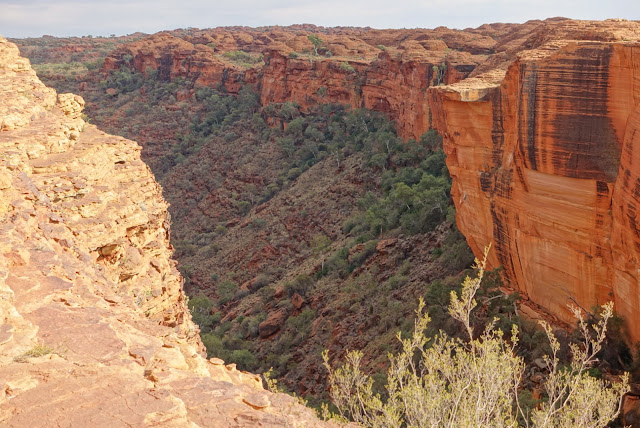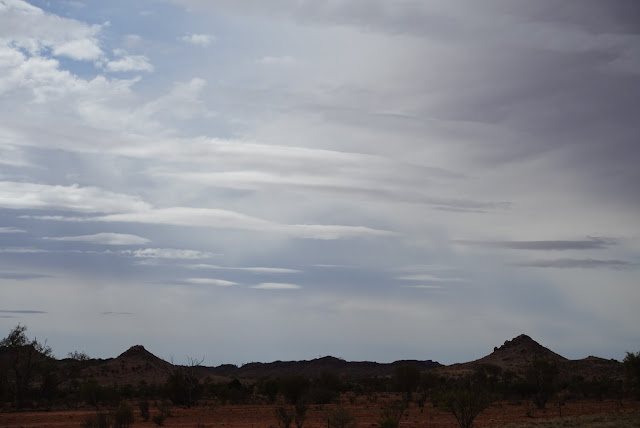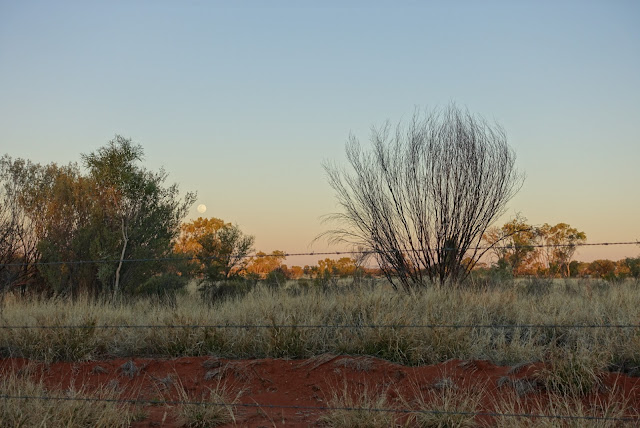Read part 1
We ride out of Yulara, back towards the Stuart Highway, with a hot crosswind (35 degrees C, 30 km/h wind) and as the road curves slightly, a one-off tailwind allows me to momentarily match my speed to the temperature. The desert oaks whistle in the wind. We camp about 10 km from Curtain Springs roadhouse that night.
Something interesting about Curtain Srings is they make their own paper from the native grasses here: spinifex, oat grass, woollybutt, kangaroo and kerosene grass. We have breakfast here the next day, ordering from the main counter behind which there is a pot plant with a sign "A real kangaroo paw" and an actual kangaroo's paw poking out from the dirt instead of its flowering namesake. We leave the roadhouse just as the motorbikes are starting to stream out again. Getting passed by motorbikes, no matter their number, is a lot less tiresome than any number of caravanners, as the motorbikes pass us easily and safely, albeit noisily. Up the road a bit there is a section of roadworks with reduced speed to 40 km/h. Despite this, a long caravan tries, at speed, to overtake me as a car approaches. The oncoming car drives off onto the dirt to avoid collision, as the caravan swings back wildly into the lane I'm in and grazes past me within 10 cm of my panniers. Dangerous idiots. I don't understand why holiday makers are in such a rush that they cannot wait 10 seconds to pass us safely. I will get off the road as a courtesy for the occasional trucks (only a few a day) if road conditions dictate, because they have schedules and dangerous loads to manage, but if I had to try get off into the dirt for every caravan that passes this way, we'd never be on the road -- there are that many of them (Also, I'm likely to come into strife in loose sand and fall under wheels, or get burr punctures in my tyres all day) The idiots just need to learn patience, share the road like the rules say they must around slower vehicles, if the want to keep their licence. The wind is in our favour at the moment. The long fingers of Grevillea, with buds ready to burst for bloom, wave us on as we pass like cheery friends.
We ride about 60 km to the turn off to Kings Canyon, and lose our tailwind as we make the turn. Suddenly it is 33 degrees and we are riding into a crosswind. A butterfly loses control in a gust and slaps me audibly on the cheek. I'm not sure what consequences that had for chaos theory. The spinifex grass that here form huge rings you could sit inside sway dramatically in the wind. The mature desert oaks prove to be lifesaving shade dispensers. A dingo hangs around the rest stop where we fill up our water bottles. The scenery, along with spinifex and desert oaks, is bloodwood, mulga, grevillea, native grasses, river reds and other gums. The headwind and heat seems to increase as the day goes on. We camp beside the beautiful Levi range, about 50 km from Kings Creek Station, on our way to Watarrka National Park.
Next day we cycle into Kings Creek Station for morning tea and Simon drinks a $5.80 small long black. We then ride on to Katherine Springs where we walk to the waterhole through some orange and chocolate coloured ridges. There are grinding stones laying about here, as well as evidence of past cattle farming, but the waterhole is amazingly clear and cool looking, a little sanctuary so beautiful as to be sacred. On the walk back out I spot many bloodwood apples, galls with edible insides. There are many flowers by the creek, releasing sugary odours attracting bees and wasps.
After taking shelter in a hot part of the day, we ride on to camp amongst some spinifex and desert oaks with a section of the George Gill range looking over us. As the sun goes down, the range comes alive with vivid colours before our eyes.
Next morning we ride early a short distance into Kings Canyon to do the 6 km (3.5 hour) rim walk. Already many tour buses are disgorging passengers. The walk begins with a steep descent ("Heart attack hill") of steps where our legs, more used to pedalling than climbing rocky stairs, are grateful for the resting plateau in the middle of the climb. We slow our pace as a European tour group is just in front of us, the guide loudly pointing out obvious things like gum trees. As the walk traces around the rim of the canyon, the vegetation changes from spinifex to hardy acacia to 400 year old cycads, to nothing but the toughest gums and cypress that have managed to send down roots amongst the rocks.
There is plenty of fun scrambling to be had in parts, as we move along the uneven rocky surface. As we walked towards a lookout, a curtain of rain came across turning the sandstone shiny in the overcast light, and a blast of wind made our vantage point feel very precarious, like we might slip off the boulders and down into the gorge below. We stand on top of about 80 metres of Mereenie sandstone (330 million years old) that lies above older Carmichael sandstone (440 million years old), with a layer of slate jammed between them. A huge chunk had falled from the North Wall of the canyon over 70 years ago and it is suggested it is due for another rock fall, so we quickly remind each other to stay clear of the edges, despite tempting views to below. Footbridges lead you down a level in order to safely cross Kings Creek, with the option here to turn off to the Garden of Eden permanent waterhole. Back up to the rim height, you can now see the Bungle Bungles-like stripped sandstone domes. Kestrel Falls wasn't flowing as we passed it, before heading down to ground level again. This walk is full of spectacle and well worth the side trip and the climbing.
Next we ride back out to Kings Creek Station. On the way we were stopped for snacks under a desert oak, when it looked like a small dust cloud was heading our way. A tractor was heading for us, cutting the small amount of native grass from the road edges, but mostly just blowing dust at us because of our headwind. We quickly pack up and ride on to avoid the tractor, when two other road workers stop their machinery and get out of them just ahead of us. One holds out a banana, an apple and a muesli bar to us, and the other yells out "Bloody legendary" in a cheery voice. We stop and have a chat and Simon accepts their food offerings, now including some fresh bread, because he can't say no. I ask them 'Howzitgoin' and one bloke shyly kicks the dirt at his feet and says "Yeah, slowly. 7 km/h. Good to see someone else travelling at our speed!" I say we have a headwind at the moment so they are probably going faster than us! We ride on to Kings Creek Station, where we eat a camel burger, and await a passing shower (timed perfectly), before riding on to camp on a short, rocky ledge that looks out over a mulga floodplain below, and is magically screened from the road by shrubs. We put our tents up amongst a line of native figs, overlooking a small rusty-red outcrop like our own mini escarpment. We keep yelling to each other "Bloody legendary!" and laughing, at the memory of those top Aussie blokes that allowed Simon to make a banana and honey sandwich in the middle of the outback.
We continue on our way back to the Lasseter Highway the next day. A side road (Ernest Giles Road) promises "98 km to Stuart Highway" and despite the large signs stating 4WD recommended, we try to ride it. After about 1 km of severely corrugated gravel, and unpredictable sand drifts that suddenly swallow your tires up to the rim and leave you motionless (or off your bike), we were defeated and turned back to the sealed. Another 25 km on, we reach a water tank, so wash some clothing, including our shirts which we put back on wet. They are dry again in 20 minutes in the warm headwind. At some point a dingo starts chasing me for about a kilometre as I ride along at 20 km/h. It must get bored with this game, as it peels off into the scrub eventually. I wasn't even aware of its presence; if I was I may have picked up the pace. Simon saw the whole thing as he travelled behind me, and told me later he assumed I knew about the large dog running behind me. We ride to make camp about 5 km from the T junction to the Lasseter Highway, amongst some beautiful shining giant spinifex rings, curious spiders, but hopefully not howling at 2 am dingos.
Next day the land is covered in a thick fog. The sun rises but it looks more like the moon as it struggles to illuminate. Slowly the fog clears and kites start circling the sky. Not far up the Lasseter Highway, a car towing a caravan pulls over in front of us and two people get out. I ride up the middle of the road - up the dotted line - as my way of saying "Not interested in whatever you are selling". The lady yells out "Are you Maree? It's Luke's mum!" as I pass. Wait, what? This is someone who actually knows me? Luke is a great mate of mine who I've known forever. I pull over and say 'G'day' to Luke's dad and shake his hand. I'm surely unrecognisable because I'm covered in dirt. We get to chatting. It's Luke's birthday so we pose for photos to send him ("Look at these two hobos I found on the side of the road. Happy Birthday"). Anyway, Simon wasn't aware we all knew each other immediately, and as he came riding up with Luke's mum taking a photo of him, he flipped her the bird and was ranting about stop taking photos without permission. Simon flipped off Luke's mum! I was making fun of him the rest of the day for that. Still am, let's be honest.
I later tell Simon the story of my mate Harry who was riding a singlespeed across Australia from east to west, Noosa to Perth, via all the dirt tracks. At the time my folks were caravanning Uluru. Everytime my dad came across a person riding he'd ask "Are you Harry??" Eventually, my folks did come across Harry, at about the same spot on the Lasseter Highway!
The headwind continues to make us suffer. We eventually make it to Mt Ebenezer roadhouse and then ride on to camp 15 km from Erldunda and the Stuart Highway to Alice Springs.
After riding into Erldunda roadhouse for breakfast, we still manage to have a warm headwind as we head north. Wedgetail eagles take off from the side of the road at regular intervals, their giant frames taking off slowly into the same headwind with a display of beautiful feathers. We click over 4000 km so far on our trip. We come across a roadkill wedgie beside the road near Palmer river and our hearts fall. The scenery is amazing, the road weaving through rocky rises and escarpments and things that look like the breakaways outside Coober Pedy. Ernest Giles Road, the other end, comes up on our left. We turn down it to head to the Henbury Meteorite Craters for camp. The road is still deeply corrugated gravel that we travel on slowly at about 5 or 10 km/h, but thankfully the sand drifts are minimal for the 15 km we need to ride it. Idiots driving fast on the dirt, trying to mimic the tv adverts that convinced them to buy the expensive toys in the first place, ruin their suspension and flick up stones. This is why the road in so corrugated.
We make it into the craters and ride around the edge of the largest. It's old and heavily worn down sides make it more like a dam than a Wolf Creek-looking impact. The rocky ridges that surround the conservation reserve delight us in the afternoon and sunset light. We have the place to ourselves now, and enjoy being able to sit at a table to eat dinner. Luxury. The moon is a giant that washes out all but the brightest stars. We bivvy under the shelter because everything else is covered in sharp stones. Before sunrise, I wake to see the moonset over a ridge -- a golden orange disc because it sets so close to sunrise time. But the sunrise gradually illumates the range once more as we pack up and head back out, the scree and spinifex enjoying every ray of light, sending out vivid colours. We breakfast as we reach the highway again, then ride on to Stuarts Well roadhouse for beer and a camel burger. Then we ride with the rugged violet Waterhouse Range on our left, to camp down a track next to a property fence a few metres from the highway.
The sunset turns the grasses over the fence into magic golden tufts and then a giant full moon rises to bathe us in light and give us moon shadows when we stand up. Trucks pass by, but eventually the road quietens down and we sleep in the red dirt track next to our bikes.
Next morning we rise before the moonset and watch it slowly reach the horizon, growing larger and more orange as it does so. As soon as it has set, the sun rises on the other side of the horizon, and we get on the road to ride the last 25 km into Alice Springs.
The last 5 km into town is madness. We appear to have arrived one hour before the 5-yearly Alice Springs Truck Parade, where road transport nerds have either done up shiny prime movers across the eras to drive in the 2 hour long parade, or are lining the highway into town with their caravans and deck chairs to watch it. We ride into town with shiny, muscle-car sounding trucks driving beside us, revving their engines for the gathering crowd, and hundreds of oldies watching us from their folding chairs. But we make it into town finally, and seek refuge near the dry, wide Todd River, away from the masses.
Monday, August 31, 2015
They must have rocks in their heads (Part 2)
Subscribe to:
Post Comments (Atom)

































3 comments:
This is prime travel writing!
And even more amazing photos of Australia up close.
My favorite quote:
"At some point a dingo starts chasing me for about a kilometre as I ride along at 20 km/h. I must get bored with this game and peels off into the scrub. I wasn't even aware of its presence; if I was I may have picked up the pace. Simon saw the whole thing as he travelled behind me, and told me later he assumed I knew about the large dog running behind me."
Clearly I need to say "piss-orf-din-go!" after all
thank you for sharing this journey, really love your use of language and knowledge about local culture and flora.
Post a Comment